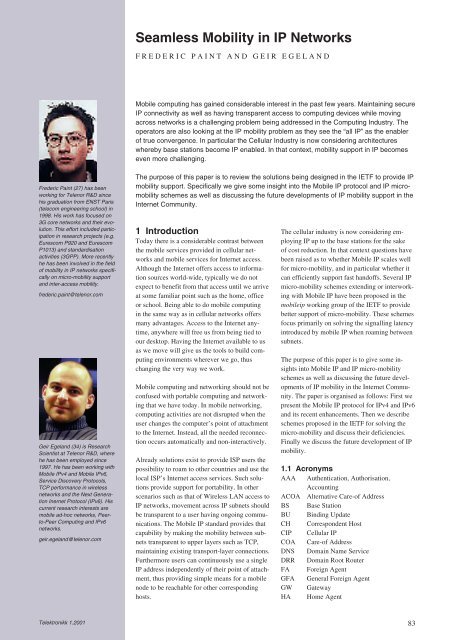Create successful ePaper yourself
Turn your PDF publications into a flip-book with our unique Google optimized e-Paper software.
Frederic Paint (27) has been<br />
working for <strong>Telenor</strong> R&D since<br />
his graduation from ENST Paris<br />
(telecom engineering school) in<br />
1998. His work has focused on<br />
3G core networks and their evolution.<br />
This effort included participation<br />
in research projects (e.g.<br />
Eurescom P920 and Eurescom<br />
P1013) and standardisation<br />
activities (3GPP). More recently<br />
he has been involved in the field<br />
of mobility in IP networks specifically<br />
on micro-mobility support<br />
and inter-access mobility.<br />
frederic.paint@telenor.com<br />
Geir Egeland (34) is Research<br />
Scientist at <strong>Telenor</strong> R&D, where<br />
he has been employed since<br />
1997. He has been working with<br />
Mobile IPv4 and Mobile IPv6,<br />
Service Discovery Protocols,<br />
TCP performance in wireless<br />
networks and the Next Generation<br />
Inernet Protocol (IPv6). His<br />
current research interests are<br />
mobile ad-hoc networks, Peerto-Peer<br />
Computing and IPv6<br />
networks.<br />
geir.egeland@telenor.com<br />
Telektronikk 1.2001<br />
Seamless Mobility in IP Networks<br />
FREDERIC PAINT AND GEIR EGELAND<br />
Mobile computing has gained considerable interest in the past few years. Maintaining secure<br />
IP connectivity as well as having transparent access to computing devices while moving<br />
across networks is a challenging problem being addressed in the Computing Industry. The<br />
operators are also looking at the IP mobility problem as they see the “all IP” as the enabler<br />
of true convergence. In particular the Cellular Industry is now considering architectures<br />
whereby base stations become IP enabled. In that context, mobility support in IP becomes<br />
even more challenging.<br />
The purpose of this paper is to review the solutions being designed in the IETF to provide IP<br />
mobility support. Specifically we give some insight into the Mobile IP protocol and IP micromobility<br />
schemes as well as discussing the future developments of IP mobility support in the<br />
Internet Community.<br />
1 Introduction<br />
Today there is a considerable contrast between<br />
the mobile services provided in cellular networks<br />
and mobile services for Internet access.<br />
Although the Internet offers access to information<br />
sources world-wide, typically we do not<br />
expect to benefit from that access until we arrive<br />
at some familiar point such as the home, office<br />
or school. Being able to do mobile computing<br />
in the same way as in cellular networks offers<br />
many advantages. Access to the Internet anytime,<br />
anywhere will free us from being tied to<br />
our desktop. Having the Internet available to us<br />
as we move will give us the tools to build computing<br />
environments wherever we go, thus<br />
changing the very way we work.<br />
Mobile computing and networking should not be<br />
confused with portable computing and networking<br />
that we have today. In mobile networking,<br />
computing activities are not disrupted when the<br />
user changes the computer’s point of attachment<br />
to the Internet. Instead, all the needed reconnection<br />
occurs automatically and non-interactively.<br />
Already solutions exist to provide ISP users the<br />
possibility to roam to other countries and use the<br />
local ISP’s Internet access services. Such solutions<br />
provide support for portability. In other<br />
scenarios such as that of <strong>Wireless</strong> LAN access to<br />
IP networks, movement across IP subnets should<br />
be transparent to a user having ongoing communications.<br />
The Mobile IP standard provides that<br />
capability by making the mobility between subnets<br />
transparent to upper layers such as TCP,<br />
maintaining existing transport-layer connections.<br />
Furthermore users can continuously use a single<br />
IP address independently of their point of attachment,<br />
thus providing simple means for a mobile<br />
node to be reachable for other corresponding<br />
hosts.<br />
The cellular industry is now considering employing<br />
IP up to the base stations for the sake<br />
of cost reduction. In that context questions have<br />
been raised as to whether Mobile IP scales well<br />
for micro-mobility, and in particular whether it<br />
can efficiently support fast handoffs. Several IP<br />
micro-mobility schemes extending or interworking<br />
with Mobile IP have been proposed in the<br />
mobileip working group of the IETF to provide<br />
better support of micro-mobility. These schemes<br />
focus primarily on solving the signalling latency<br />
introduced by mobile IP when roaming between<br />
subnets.<br />
The purpose of this paper is to give some insights<br />
into Mobile IP and IP micro-mobility<br />
schemes as well as discussing the future developments<br />
of IP mobility in the Internet Community.<br />
The paper is organised as follows: First we<br />
present the Mobile IP protocol for IPv4 and IPv6<br />
and its recent enhancements. Then we describe<br />
schemes proposed in the IETF for solving the<br />
micro-mobility and discuss their deficiencies.<br />
Finally we discuss the future development of IP<br />
mobility.<br />
1.1 Acronyms<br />
AAA Authentication, Authorisation,<br />
Accounting<br />
ACOA Alternative Care-of Address<br />
BS Base Station<br />
BU Binding Update<br />
CH Correspondent Host<br />
CIP Cellular IP<br />
COA Care-of Address<br />
DNS Domain Name Service<br />
DRR Domain Root Router<br />
FA Foreign Agent<br />
GFA General Foreign Agent<br />
GW Gateway<br />
HA Home Agent<br />
83

















